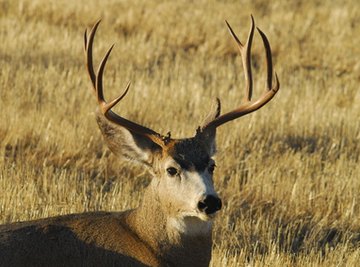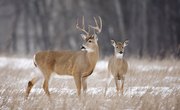
Deer antlers are growths of bone that deer and similar animals produce for mating season. Only male deer produce antlers, and few deer keep their antlers for long periods. Contrary to popular belief, the size of the antlers and the number of points do not indicate the age of the deer. The size of the antlers are decided by the health of the deer and its access to nutrients.
Deer Antlers
Deer antlers are primarily grown for mating purposes. A male deer not only shows off its antlers to prove its health, but also uses them to battle other male deer for supremacy and choice of mates. Only caribou females also grow racks of antlers. The shorter antlers most female deer grow are used to fend off males as they look for food for themselves and their young in winter. Elk also keep their antlers year-round and use them to fight for food sources.
Materials
Deer antlers take a lot of energy to grow. The antlers are bony, and like bones are made mostly out of calcium. Deer do not consume much calcium with their vegetarian diet, and the calcium in the antlers is grown just like the calcium in the bones, produced by chemical reactions in their bodies. This takes up a large amount of available nutrients and energy, and only the healthiest deer can grow large antlers.
Growth Rate
Even the largest antlers grow from small nubs to full size in three to four months, making them one of the fastest-growing types of tissue. They begin as small bony growths at the top of the head, and are covered with a layer of skin and hair known as velvet. This velvet keeps the antlers protected while they are fragile.
Maturity
When antlers have reached a larger size and slow down or stop growing, the blood vessels that keep the velvet growing shut down around the base of the antlers. This causes the velvet skin to die and eventually peel away, sometimes leaving trailing and hanging bits for a few weeks. Male deer typically rub their antlers against trees and other objects to remove the peeling velvet.
Shedding
Because deer antlers take up so much energy, it is advantageous for many smaller deer to shed them as quickly as possible after mating season ends. The deer draw calcium and similar nutrients back into the system, so that the antlers become brittle and drained. A layer of cells grows at the base of the antlers, gradually severing their connection to the body and causing them to falling off.
References
About the Author
Tyler Lacoma has worked as a writer and editor for several years after graduating from George Fox University with a degree in business management and writing/literature. He works on business and technology topics for clients such as Obsessable, EBSCO, Drop.io, The TAC Group, Anaxos, Dynamic Page Solutions and others, specializing in ecology, marketing and modern trends.
Photo Credits
Antlers image by Charles Kaye from Fotolia.com
